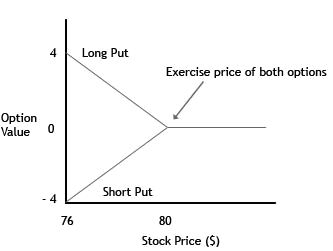CFA Level 1 - Derivatives
Both put and call options have three basic characteristics: exercise price, expiration date and time to expiration.
Example: Call Option
IBM is trading at 100 today. (June 1, 2005 )
The call option is as follows:Strike price = 120, Date =August 1, 2005, Premium on the call = $3
In this case, the buyer of the IBM call today has to pay the seller of the IBM call $3 for the right to purchase IBM at $125 on or beforeAugust 1, 2005 . If the buyer decides to exercise the option on or before August 1, 2005 , the seller will have to deliver IBM shares at a price of $125 to the buyer.
Example: Put Option
IBM is trading at 100 today (June 1, 2005 )
Put option is as follows:Strike price = 90, Date =August 1, 2005, Premium on the put = $3.00
In this case, the buyer of the IBM put has to pay the seller of the IBM call $3 for the right to sell IBM at $90 on or beforeAugust 1, 2005 . If the buyer of the put decides to exercise the option on or before August 1, 2005 , the seller will have to purchase IBM shares at a price of $90.
Example: Interpreting Diagrams
For the exam, you may be asked interpret diagrams such as the following, which shows the value of a put option at expiration.
A typical question about this diagram might be:
- The buyer has the right to buy or sell the asset.
- To acquire the right of an option, the buyer of the option must pay a price to the seller. This is called the option price or the premium.
- The exercise price is also called the fixed price, strike price or just the strike and is determined at the beginning of the transaction. It is the fixed price at which the holder of the call or put can buy or sell the underlying asset.
- Exercising is using this right the option grants you to buy or sell the underlying asset. The seller may have a potential commitment to buy or sell the asset if the buyer exercises his right on the option.
- The expiration date is the final date that the option holder has to exercise her right to buy or sell the underlying asset.
- Time to expiration is the amount of time from the purchase of the option until the expiration date. At expiration, the call holder will pay the exercise price and receive the underlying securities (or an equivalent cash settlement) if the option expires in the money. (We will discuss the degrees of moneyness later in this session.) The call seller will deliver the securities at the exercise price and receive the cash value of those securities or receive equivalent cash settlement in lieu of delivering the securities.
- Defaults on options work the same way as they do with forward contracts. Defaults on over-the counter option transactions are based on counterparties, while exchange-traded options use a clearing house.
Example: Call Option
IBM is trading at 100 today. (
The call option is as follows:Strike price = 120, Date =
In this case, the buyer of the IBM call today has to pay the seller of the IBM call $3 for the right to purchase IBM at $125 on or before
Example: Put Option
IBM is trading at 100 today (
Put option is as follows:Strike price = 90, Date =
In this case, the buyer of the IBM put has to pay the seller of the IBM call $3 for the right to sell IBM at $90 on or before
Example: Interpreting Diagrams
For the exam, you may be asked interpret diagrams such as the following, which shows the value of a put option at expiration.
 |
A typical question about this diagram might be:
Q: Ignoring transaction costs, which of the following statements about the value of the put option at expiration is TRUE?
A. The value of the short position in the put is $4 if the stock price is $76.
B. The value of the long position in the put is $4 if the stock price is $76.
C. The long put has value when the stock price is below the $80 exercise price.
D. The value of the short position in the put is zero for stock prices equaling or exceeding $76.
The correct answer is "C". A put option has positive monetary value when the underlying instrument has a current price ($76) below the exercise price ($80).






0 comments:
Post a Comment